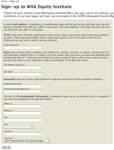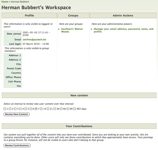People
Signing Up
The easiest way for a new user to join the site is to signup directly. The configurable new user form requires names, an email address, and a password; other demographic data can be collected as well. When the user submits this form, a confirmation email gets sent to the address with an embedded link that, when clicked, completes the registration. This email confirmation step prevents non-working email addresses from polluting the user base in the system. |
Adding Users
New users can optionally be added in bulk by a system administrator using a simple form in which each user is listed by name and email address, one to a line. Optionally the users can be added to a group at the site during this registration. This process permits fast addition of new people — but with a couple of disadvantages: users aren’t able to setup their own passwords this way and must go through the “I can’t remember my password” drill to get in the first time. Also, this process does not confirm that the email address actually does work. So, it’s best to have new people sign themselves up. |
Roles
Once people are in the site’s database, they can be assigned various roles that grant them “superpowers” to do various kinds of activities on the site. These roles are configurable when new packages are added to the platform, but all the primary packages use these roles: Editor, Publisher, Group Admin, and Sitewide Admin. These roles are primarily categorical. For instance, Editors can author pages and other content on the site, Publishers can create new FAQs and other content resources, Group Admins can add and remove users from Groups and assign them roles, and the Sitewide Admin has overall God Powers at the site. This role system and group memberships give site administrators deft and expressive tools for organizing people using the site. Experienced users who are trusted to participate in the care and growth of the site get the permissions to do this work, while more nominal members can access, view, and consume content but not alter it. |
Workspaces
Contributions
Personalization
When a user is logged in, her experience throughout the site is automatically tailored for her. Her name is always visible, confirming that the site knows who she is. Times are adjusted for her time zone. Access to pages depend on her identity and roles, as do links on those pages.
Created: September 15, 2009 19:45
Last updated: March 07, 2010 23:35






Comments
No comments yet.
To comment, you must log in first.